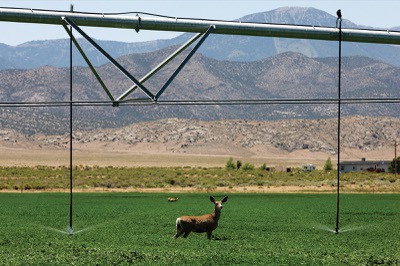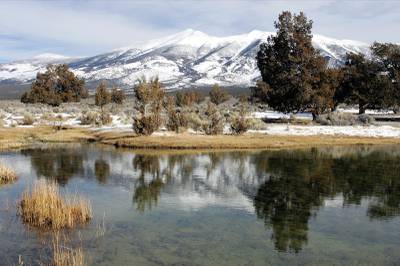
The Wheeler Peak Glacier in Nevada is a block of ice covered by piles of rocks. Millennia ago, it was a textbook glacier — like something in Antarctica. Researchers are trying to find out more about the glacier’s size and effect on high-altitude ecosystems.
Monday, Nov. 23, 2015 | 2 a.m.
Wheeler Peak Glacier lies above a high-desert grove of bristlecone pines on top of a moraine of granite boulders in Nevada’s Great Basin National Park.
On a warm fall afternoon, the glacier bears little resemblance to the mammoth ice structures people typically associated with Antarctica. Rather, piles of loose rock are enveloped by a jagged amphitheater that reaches more than 13,000 feet in the sky.
More than 10,000 years ago, Wheeler Peak Glacier was a textbook glacier, a behemoth of dense ice jammed inside a mountain. Today, that’s no longer the case. Like an old-fashioned cooler, all that’s left of Nevada’s only glacier is an ice block insulated by tons of surrounding rock.
Visitors often associate the “rock glacier” with the snow and ice fields that once filled the area year-round.
Ed Janov has trekked to the glacier four times, most recently two months ago. After reaching the summit of the enormous heap, the Las Vegas resident was brisk in his reaction.
“It’s gone,” he said.
As the climate changes, disappearing snow and ice on Wheeler Peak — Nevada’s second-highest mountain — raise concerns about the future of water in the state, for which the glacier plays an integral role.
Less snowpack means less insulation for the glacier and less runoff for the park’s springs and streams that refill the basin’s aquifer. If there’s less insulation for the glacier, more of it will melt at a faster pace. As years go on, less snowmelt and glacier melt could mean less vegetation and food for wildlife.
Climate change is expected to hit alpine ecosystems like Mount Wheeler’s hardest, said Steven Mietz, superintendent of Great Basin National Park.
Park officials aren’t blind to the potential effects. Scientists have been studying the Great Basin ecosystem to learn more about what could be lost if Wheeler Peak Glacier were to disappear.
The region could be a baseline for measuring how nature reacts to global warming, Mietz said.
“The glacier is a canary in a coal mine,” he said.
Scientists from Ohio State University set up cameras to monitor the glacier, lakes, weather and water flow. The data will create a barometer park officials can use to measure the size and scope of the glacier.
Scott Reinemann, who worked on the study, said photos from as recently as 2005 show blankets of snow covering the glacier in summer. Since 2012, gray rock has been the predominant feature in summer.
“The biggest thing we’ve noticed in the 10 years we’ve been going there is the amount of snow in July and August,” Reinemann said. “It’s all gone.”
National parks across the Western United States are seeing glaciers melt, migration patterns change and coasts erode. Both Glacier National Park and Joshua Tree National Park have seen their eponymous attractions shrivel. Wildlife have less to eat. The risk of wildfires and floods has increased.
Conservationists want the public to know that irreparable changes are taking place.
“Nevadans need to know that the evidence of climate change is in our backyard at Great Basin,” said Lynn Davis, Nevada program manager of the National Parks Conservation Association. “I have witnessed the snowpack up there disappear. It is an issue that the parks and organizations like mine are grappling with.”



Join the Discussion:
Check this out for a full explanation of our conversion to the LiveFyre commenting system and instructions on how to sign up for an account.
Full comments policy